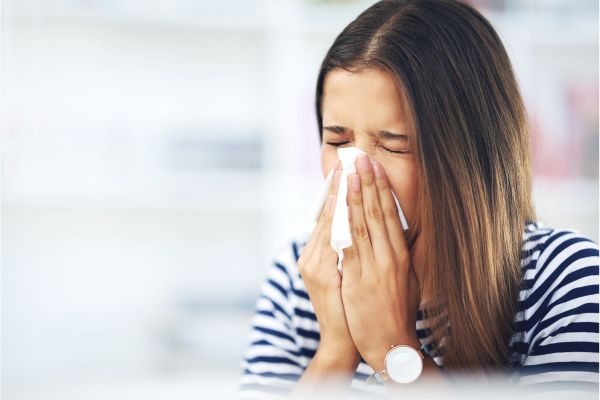Understanding the Problem: How Allergens Build Up
Fabric surfaces like clothes, sheets, and curtains are magnets for allergens. They trap particles from the environment and come into close contact with your skin and respiratory system. Here are some common culprits:
-
Dust Mites: These microscopic organisms thrive in bedding and upholstered surfaces, feeding on dead skin cells. Their droppings are a leading cause of indoor allergies.
-
Pet Dander: Hair and skin flakes from pets can stick to clothing, furniture, and linens, exacerbating allergy symptoms.
-
Pollen: During allergy season, pollen grains cling to your clothes and are brought indoors, triggering reactions.
-
Mold and Mildew: Damp laundry or improperly dried fabrics can become a breeding ground for mold, which releases allergenic spores into the air.
How Laundry Can Help Manage Allergies
Regular laundry routines can drastically reduce the number of allergens in your living space. Here’s how:
-
Wash Bedding Weekly: Your bed is one of the primary hotspots for dust mites. Washing sheets, pillowcases, and duvet covers in hot water (at least 130°F/55°C) kills dust mites and removes allergens effectively. Don’t forget to clean mattress covers and blankets every 1-2 weeks.
-
Vacuum and Wash Curtains Regularly: Curtains can trap dust, pollen, and pet dander. Clean lightweight curtains in the washing machine and vacuum heavier drapes with a brush attachment every few weeks.
-
Clean Throw Pillows and Upholstery: Wash removable pillow covers and vacuum or steam clean non-removable ones. For heavily used areas, consider allergy-resistant fabric sprays.
-
Use Hypoallergenic Detergents: Some detergents contain fragrances or chemicals that can irritate sensitive skin or trigger allergic reactions. Opt for hypoallergenic, fragrance-free detergents to minimize the risk.
-
Dry Thoroughly: Mold thrives in damp environments, so ensure clothes and linens are completely dry before folding or storing. If line drying, avoid outdoor exposure during high pollen seasons.
Laundry Tips for Allergy Prevention
-
Wash New Clothes Before Wearing: New clothing often contains chemical residues from manufacturing that can irritate sensitive skin. A quick wash removes these irritants.
-
Use a High-Efficiency Washer and Dryer: Modern machines with advanced allergen-removal settings can eliminate more particles than standard cycles.
-
Don’t Overload the Washer: Overloading can prevent thorough cleaning and rinsing, leaving allergens behind. Stick to recommended load sizes for optimal results.
-
Upgrade Your Washing Techniques: Add baking soda to remove odors or a cup of vinegar during the rinse cycle for a natural fabric softener and allergen fighter.
-
Store Items Properly: Keep washed clothes and linens in airtight storage to prevent dust buildup or exposure to allergens before use.
When Professional Laundry Services Can Help
Sometimes, your laundry routine needs an extra boost to tackle allergens effectively. Professional laundry services like Tip Top Laundry can make a significant difference in allergy management. Here’s how:
-
Deep Cleaning Expertise: Laundry services use industrial machines and high-temperature settings that kill dust mites, mold spores, and bacteria more effectively than home washers.
-
Specialized Detergents: Services often provide hypoallergenic and fragrance-free detergent options to suit sensitive skin.
-
Convenience for Busy Schedules: If managing allergy-specific laundry feels overwhelming, let a professional handle the cleaning, drying, and folding for you.
-
Large or Delicate Items: Services can handle bulky items like comforters, drapes, or rugs that are difficult to wash at home.
Additional Steps to Minimize Allergens
Laundry alone won’t eliminate all allergens, but combining these practices with your cleaning routine can make a big impact:
-
Vacuum Often: Use a vacuum with a HEPA filter to trap allergens in carpets and furniture.
-
Invest in Air Purifiers: HEPA air purifiers reduce airborne allergens, complementing your laundry efforts.
-
Shower Before Bed: Rinse off pollen and dander to prevent allergens from transferring to bedding.
-
Declutter: Remove unnecessary fabric surfaces like excessive throw pillows or stuffed animals, which can harbor dust.
The Takeaway
Managing allergies involves a multifaceted approach, and laundry plays a vital role in reducing exposure to common irritants. With proper washing techniques and a consistent routine, you can minimize allergens on clothes, bedding, and household fabrics. And when the workload feels too heavy or requires expert care, professional services like Tip Top Laundry can step in, ensuring your items are thoroughly cleaned and allergy-friendly.
By staying proactive with your laundry habits, you’ll create a healthier, more comfortable space for yourself and your family. Clean clothes and linens aren’t just about appearance - they’re a step toward better breathing and overall wellness.
